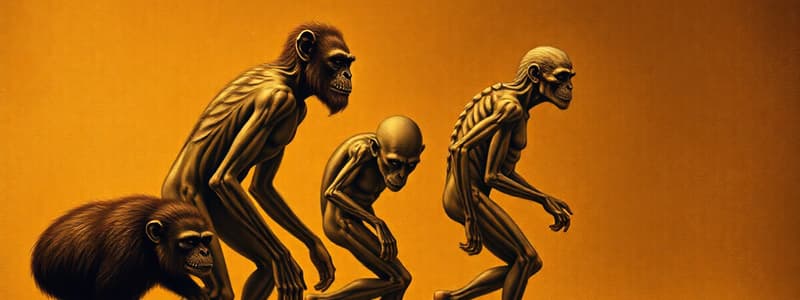Podcast
Questions and Answers
Which of the following early hominids is known for being one of the first species using tools?
Which of the following early hominids is known for being one of the first species using tools?
- Homo habilis (correct)
- Homo erectus
- Homo sapian
- Australopithecus
What is the term for individuals who move to a new country to live permanently?
What is the term for individuals who move to a new country to live permanently?
- Refugees
- Emigrants
- Immigrants (correct)
- Tourists
Which factor primarily influences high death rates in a population?
Which factor primarily influences high death rates in a population?
- High fertility rates
- Access to healthcare
- Natural disasters (correct)
- Social stability
What does the term 'spatial distribution of population' refer to?
What does the term 'spatial distribution of population' refer to?
Which of the following was a significant factor in Charles Darwin's theory of evolution?
Which of the following was a significant factor in Charles Darwin's theory of evolution?
Flashcards
Human Evolution
Human Evolution
The process by which humans have evolved over millions of years from ape-like ancestors.
Archaeology
Archaeology
The study of past human societies through the analysis of material remains, like tools, bones, and buildings.
Fossil
Fossil
The preserved remains of ancient organisms, often found in rock formations.
Homo habilis
Homo habilis
Signup and view all the flashcards
Homo sapiens
Homo sapiens
Signup and view all the flashcards
Study Notes
Human Evolution Overview
- Human evolution is a complex process tracing the development of humans from their earliest ancestors.
- Key figures in this study include Charles Darwin, who proposed the theory of evolution by natural selection.
- Fossils provide crucial evidence for understanding past human species.
- Hominids include species like Australopithecus, Homo habilis, Homo erectus, and Homo sapiens (modern humans). Each exhibits unique characteristics contributing to the evolutionary path.
Key Concepts and Terms
- Homo habilis: An early human species characterized by its tool-making abilities.
- Homo erectus: An ancestor species exhibiting larger brain size compared to Homo habilis. This species also showed evidence of migration and adaptation to various environments.
- Homo sapiens: Represents modern humans, distinguished by advanced cognitive abilities and cultural development.
- Emigrant: A person leaving their country of origin to live in another.
- Immigrant: A person entering a new country to live permanently.
- Fertility: The ability to produce offspring. A factor in population growth.
- Mortality: The rate of death within a population. A key factor affecting population size.
- Factor of high death rate: Factors contributing to high mortality rates, like diseases, resource scarcity, or conflict.
- Population distribution: The way a population is spread across a geographical area. Influenced by both physical and human factors.
- Factor of population distribution (physical and human factor): Physical factors include geography, climate, resources. Human factors include culture, economy, and politics.
- Spatial distribution of population (population settlement rural urban, international and international movement): Different patterns of population distribution. This includes rural and urban settlements, as well as international and internal population movements.
- Mode of transport: The methods used to travel, impacting population distribution and interactions.
Studying That Suits You
Use AI to generate personalized quizzes and flashcards to suit your learning preferences.



